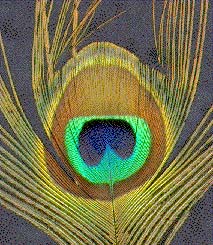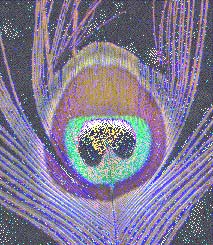Exploring the Fourth Dimension
The vivid colours of many animals and plants are not only a source of inspiration to artists and poets, but are of great interest to evolutionary biologists. Ever since Darwin, biologists have used colour variation to test the theory of natural selection itself, and more specific evolutionary theories of signalling, crypsis, mimicry and warning coloration, to name but a few. But in the last decade, the hottest area of research has been sexual selection, Darwin's theory of how female mating preferences can lead to the elaboration of colourful ornaments such as the peacock's tail. Indeed, birds have been the most popular group for such research, but scientists in the Ecology of Vision group at the School of Biological Sciences (University of Bristol) have argued that much of this work is fundamentally flawed.
Introduction
If you watched a wildlife series with, say, the red light source of your television removed (or if you were red-green "colour-blind") and you then came up with conclusions about colour variation in the natural world, would anyone believe you? Probably not, but then that is what we humans are doing every time we think we are seeing the colour world of non-human animals. Unlike other variables such as length, width, mass, or time of day, colour is not an inherent property of the object; it is a property of the nervous system of the animal perceiving the light. In an interdisciplinary collaboration Andrew Bennett, Innes Cuthill and Julian Partridge have been combining techniques from visual physiology and behavioural ecology to investigate the colour world of birds.
Colour Vision in Humans
The sensation of colour stems from the differential stimulation of the different types of photoreceptors in the retina. Each cone type produces an output, and it is their differences in output at a particular point on the retina which underlies the sensation of colour. In humans there are only three types of cones, absorbing maximally in different regions of the spectrum. Due to the appearance (to humans) of monochromatic light at these wavelengths, these three cone types are called "red", "green" and "blue" respectively. Consequently, for humans, all hues can be produced by mixing red, green and blue light. This is how a colour television set works; a mixture of three wavelengths produces several million apparent "colours". This mechanism has a number of consequences. (1) Different wavelength spectra can produce the same hue; as long as the output from the three types of cone remains the same, the hue is the same. (2) The same wavelength spectra will produce different hues to animals that differ in the absorption spectra of their cone types. (3) Humans have trichromatic, or three-dimensional, colour vision because we have three interacting cone types. Animals with two interacting cone types, such as most mammals other than old-world primates, have two-dimensional colour vision (similar perhaps to the faulty colour TV set mentioned earlier). It is harder to imagine what colour vision with more dimensions than three might be like, but animals with 4 and 5-dimensional colour vision exist.


Colour Vision in Birds
Bird colour vision differs from that of humans in two main ways. First, birds can see ultraviolet light. It appears that UV vision is a general property of diurnal birds, having been found in over 35 species using a combination of microspectrophotometry, electrophysiology, and behavioural methods. So, are birds like bees? Bees, like humans, have three receptor types, although unlike humans they are sensitive to ultraviolet light, with loss of sensitivity at the red end of the spectrum. This spectral range is achieved by having a cone type that is sensitive to UV wavelengths, and two that are sensitive to "human visible" wavelengths. Remember, because 'colour' is the result of differences in output of receptor types, this means that bees do not simply see additional 'UV colours', they will perceive even human-visible spectra in different hues to those which humans experience. Fortunately, as any nature film crew knows, we can gain an insight to the bee colour world by converting the blue, red and green channels of a video camera into UV, blue and green channels. Bees are trichromatic, like humans, so the three dimensions of bee colour can be mapped onto the three dimensions of human colour. With birds, and indeed many other non-mammalian vertebrates, life is not so simple. As well as seeing very well in the ultraviolet, all bird species that have been studied have at least four types of cone. They have four, not three, dimensional colour vision. Recent studies have confirmed tetra-chromacy in some fish and turtles, so perhaps we should not be surprised about this. It is mammals, including humans, that have poor colour vision! Whilst UV reception increases the range of wavelengths over which birds can see, increased dimensionality produces a qualitative change in the nature of colour perception that probably cannot be translated into human experience. Bird colours are not simply refinements of the hues that humans, or bees, see, these are hues unknown to any trichromat.
Investigating animal colours
Why have so many behavioural and evolutionary ecologists failed to recognise that human colour perceptions are irrelevant for their studies? One reason is the feeling, long dismissed by philosophers, that perception mirrors an objective reality. Yet whilst reflectance spectra can be quantified independent of the observer, colours cannot. Second, until relatively recently it was thought that humans had amongst the best colour vision of any animal, and that most animals' spectral sensitivities lay within the human-visible spectrum. This misapprehension still persists outside the visual sciences. A corollary is that we have long accepted that birds have (human-like) colour vision because many birds are colourful to us. The notion that plumages may be even more colourful to birds, or simply colourful in different ways, has not been widely considered, even though we readily accept that a dog's sense of smell is far richer than our own. The fact that human colour experience can only really be applied to other old world primates has important consequences for testing evolutionary hypotheses. Many of the objects to which evolutionary hypotheses apply, reflect in the UV. Many fruit, flowers, and seeds contrast with their background much more strongly in UV than human-visible wavelengths. Furthermore, and of particular interest to research on sexual selection and mate choice, so do many species of birds' plumage. For example, male and female blue tits look similar to us, but there is a significant sex difference in the UV reflection of several plumage regions (e.g. the 'blue' crest). Some 'human-white' feathers are UV-reflecting, some are not. Reflectance spectroradiometry and multi-spectral cameras that extend into the ultraviolet allow the Bristol team to quantify plumage patterns objectively. By using selective filters to cut out particular wavelengths of light, behavioural experiments have already shown that the ultraviolet component of plumage colours is important in mate choice decisions for species such as starlings and zebra finches. The Bristol approach is to link behavioural ecology to a research program in colour cognition, for if we wish to understand evolutionary hypotheses involving colour we need to understand how animals perceive colour. Ultimately this will not only improve our understanding of animal signals, but might give us an insight to the function and evolution of the different colour vision systems that exist across the animal kingdom.
Credits to University of Bristol Biological Sciences Department